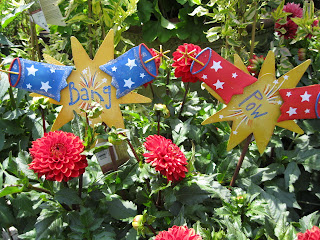 |
| Happy Fourth of July! |
"Though an old man, I am but a young gardener," he said. For me, his comment perfectly sums up the appeal of gardening -- one is constantly learning and growing.
He wasn't the only Founding Father who was an avid gardener, however. Others who planted extensive landscapes included George Washington, John Adams and James Madison, our first, second and fourth Presidents respectively.
Gardens, for them, were often a way to cope with the pressures of political life.
"As much as I converse with sages and heros, they have very little of my love or admiration," John Adams wrote to his wife Abigail in a letter dated July 3, 1776. "I should prefer the delights of a garden to the dominion of a world."
Washington retreated to his Mount Vernon estate when he wasn't fighting the British or running the country. Alexander Hamilton, the first secretary of the U.S. Treasury, did likewise when he left office.
"A garden, you know, is a very usual refuge of a disappointed politician," he wrote to a friend. "Accordingly I have purchased a few acres about nine miles from town, have built a house and am cultivating a garden."
Gardens with native trees and shrubs also inspired the Founding Fathers, giving them hope that the rich and diverse plant life of their fledgling nation would help it remain independent and prosper.
Ironically, Jefferson and Adams also discovered in 1786 that the "hottest" garden trend in England at the time used native American plants. It was easy for Americans to duplicate that look because it involved their own country's plants arranged in a naturalistic style.
Wulf, a British garden historian, noted that several members of the Constitutional Congress took a short break from their deadlocked deliberations in July 1787 to tour the Bartram Garden in Philadelphia. The property included plant material from all of the 13 former colonies, all growing in harmony. The visit may have helped break a stalemate over the structure of Congress, she said.
"It can only be speculation that a three-hour walk on a cool summer morning among the United States of America's most glorious trees and shrubs influenced these men," Wulf wrote. "But what we do know is that the three men who changed sides and made the Great Compromise possible that day had all been there and marveled at what they saw."
So if you find yourself in or near a garden this Fourth of July, take a few moments to reflect on the diversity of America's native plants. It played an important role in the formation of our country.
Have a safe and happy Independence Day!
By Karen Geisler


No comments:
Post a Comment